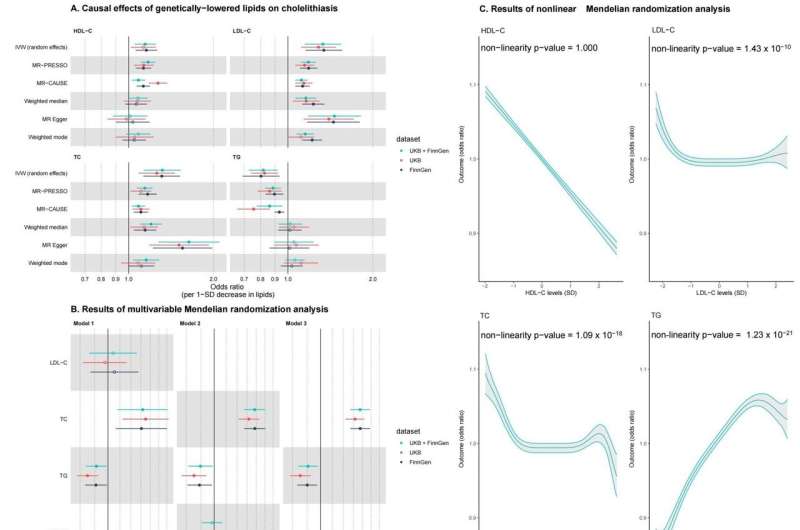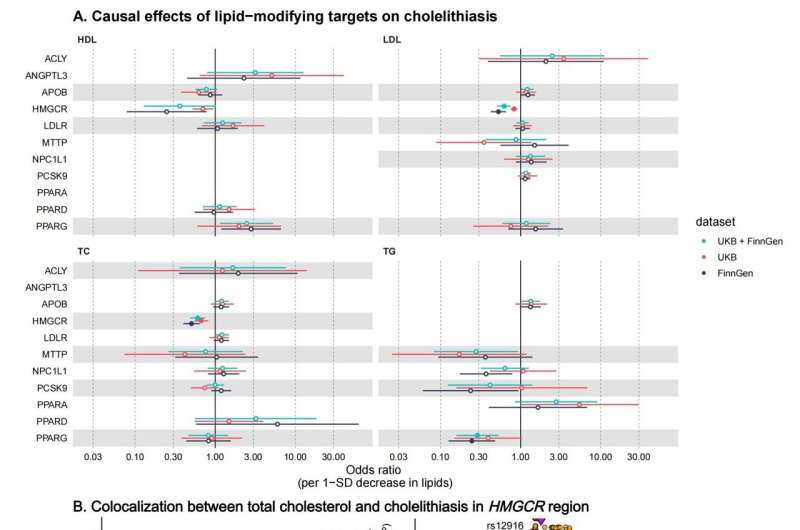This article has been reviewed according to Science X's editorial process and policies. Editors have highlighted the following attributes while ensuring the content's credibility:
fact-checked
peer-reviewed publication
proofread
New study sheds light on link between lipids and gall stones

A new study published in the journal Gut has shed light on the complex relationship between serum lipids, lipid-modifying targets, and cholelithiasis, a common condition characterized by the formation of gallstones. The study, led by researchers at the First Hospital of Jilin University, employed a combination of observational and Mendelian randomization (MR) approaches to comprehensively assess these associations.
Cholelithiasis is a prevalent hepatobiliary disorder that primarily affects Western populations. It is a significant risk factor for cholangiocarcinoma, a type of bile duct cancer. Understanding the factors influencing cholelithiasis risk is crucial for developing effective prevention and treatment strategies.
Previous research has explored the role of serum lipids and lipid-modifying targets in cholelithiasis development. However, findings have been inconsistent, highlighting the need for further investigation. The current study aimed to address this gap by conducting a comprehensive analysis of these relationships.
The study utilized data from the UK Biobank, a large-scale biobank resource, to examine the associations between serum lipids (total cholesterol, LDL-C, HDL-C, and triglycerides) and cholelithiasis risk. The researchers found that serum LDL-C and HDL-C levels were inversely associated with cholelithiasis risk, indicating that lower LDL-C and higher HDL-C levels were associated with a reduced risk of gallstone formation.
Interestingly, the relationship between serum total cholesterol and cholelithiasis was non-linear, with lower cholesterol levels associated with an increased risk of gallstones. This finding contrasts with conventional wisdom, which suggests that lower cholesterol levels are generally beneficial for health.

The researchers also employed MR, a genetic approach, to investigate the causal effects of serum lipids and lipid-modifying targets on cholelithiasis risk. MR utilizes genetic variants as proxies for specific risk factors, allowing for assessing causal relationships without the confounding effects of lifestyle and environmental factors.
MR analyses supported the observational findings, confirming that lower serum total cholesterol and higher triglyceride levels were independent causal risk factors for cholelithiasis.
The findings of this study provide valuable insights into the complex interplay between serum lipids, lipid-modifying targets, and cholelithiasis risk. The researchers suggest that these findings could inform the development of personalized risk assessment strategies and potential therapeutic interventions for cholelithiasis prevention.
Further research is warranted to elucidate the underlying mechanisms behind the observed associations and identify specific lipid-modifying targets that may hold promise for preventing or treating cholelithiasis.
More information: Lanlan Chen et al, Novel insights into causal effects of serum lipids and lipid-modifying targets on cholelithiasis, Gut (2023). DOI: 10.1136/gutjnl-2023-330784



















